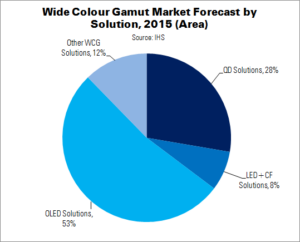25% of the 2020 display market, in terms of area, will feature a wide colour gamut (WCG), says IHS – up from 3% this year. The majority of WCG unit shipments today are formed of OLED smartphones; however, TV displays will make up 52% of the WCG display area market this year, and 86% in 2020.
Richard Son, IHS senior analyst, said, “Resolution and screen size are key factors in display technology evolution, but technical hurdles and technical gaps among panel makers have recently narrowed… Display manufacturers are, therefore, looking for emerging technologies to widen the colour gamut of their displays and increase the high dynamic range of their products, in order to gain a competitive advantage in the market”.
Three technologies are used to achieve WCG on displays: OLED (100% NTSC), LED-LCD with revised LEDs and colour filters (80-90% NTSC) and quantum dots (‘similar’ in gamut to OLED). More than half of the WCG display market this year will be formed of OLED screens.
“For some time now, display manufacturers have attempted to attain wider color gamut in their display products, but they were unable to find reliable, mainstream solutions to do so”, says Son. “[H]owever, with the advent of quantum dot technology and OLED, wide colour gamut technologies have become much more common in the industry”.
Analyst Comment
Content remains the challenge for WCG in most applications, especially TV. All of the HD TV standards were based on Rec. 709, which is very close to sRGB and is based on CRT performance. As a result, all TV programmes and DVD & Blu-ray content is mastered for Rec. 709. UltraHD Blu-ray will have the option of supporting wider gamuts and that should help to ensure more content that is properly rendered. (BR)

